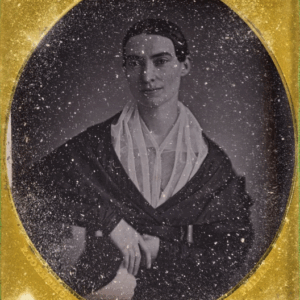JTF (just the facts): A total of 52 color photographs, variously framed and displayed, and hung against white walls (with blue and yellow stripes) on the upper and lower floors of the gallery space and the entry area. In the upstairs area, 12 of the works are metallic lambda prints on 3mm Dibond with custom frames, made between 2001 and 2010. Physical sizes range from 24×36 to 40×57 (or reverse), the prints available in editions of 7 or 10. The other 4 works are black and white c prints on Fuji Crystal with custom frames, made between 2007 and 2010. These prints range from 37x51to 39×53 (or reverse), in editions of 7.
In the downstairs area, 11 of the works are unique giclee prints with acrylic painting, in custom tire frames, made in 2000. All of the works are 20×16, except one diptych of 24×18 prints. 24 additional works are hung in a pyramid shape, each a 13×11 print on cardboard (a soda case) and made in 2014. The installation on the lower level also includes 1 video, 1 black and white c print in a custom subframe, 3 dolls in glass cases, and a seating arrangement of cushions, plastic crates, paint cans, and perforated tin lamps. A monograph of Hajjaj’s work is available from the gallery for $50. (Installation shots below.)
Comments/Context: Hassan Hajjaj’s photographs of brash Moroccan women on motorcycles and scooters come together at a cultural crossroads, at a place where Arab and Western traditions mix and high and low culture intermingle. In a melting pot like Marrakesh, these influences restlessly combine and conflict until they have been forged together into something altogether new and unexpected. Hajjaj’s bold artworks amplify and exaggerate these connections, in the process showing us a sassy, irreverent kind of modern Arab woman that falls far outside the usual stereotypes of submissive female deference.
One glance at Hajjaj’s photographs and it is clear his visual style is a merging of photographic approaches: one part African studio portraiture and an equal measure of risk taking, high fashion glamour. Like the works of Seydou Keïta and Malick Sidibé, his images often rely on studio staging, where his subject perches on a motorcycle, flanked by the clashing geometric patterns of woven plastic sheeting and adorned with carefully chosen props. His women are still clothed in variations on traditional veils and djellabahs, but they exude an unmistakable playful energy, their robes not ordinary black but a rainbow of colorful dots and eye catching prints. Zig zag floors give way to heart shaped plastic sunglasses, fake Nike slippers, and shiny watches, eyes peering out with rebellious swaggering confidence. Outdoor shots use mosques and stone walled alleys as backdrops, the impertinent female cycle culture given more context. Each print is then surrounded by a custom wooden frame, filled with blocked niches of everyday consumer products: canned tomatoes and spam, Pepsi and Mountain Dew, plastic alphabet blocks and Coca-Cola. The repeated graphics create a Warholian pattern of Arabic logos that adds a physical object quality to the works and reinforces the constant cultural remixing that Hajjaj is interested in.
In the downstairs gallery, Hajjaj further explores material reuse, making painted portrait frames out of nubbed rubber car tires and a lounge seating arrangement out of scavenged paint cans and plastic crates, each upholstered and embroidered in signature Louis Vuitton fabrics. A selection of new works finds Hajjaj reinterpreting himself and drawing on David Levinthal, perching female dolls on toy motorcycles made from soda cans, setting them amid designer fabrics, and printing them on the bottom of cardboard soda cases. It’s as if the visual ideas (and advertising motifs) are being constantly morphed and reconsidered.
The best of Hajjaj’s works are filled with a fresh, defiant fun, his subjects caught both vamping and aspirationally cool, drowning in a sea of pop culture brands. In his hands, products have become a kind of reusable makeshift couture, opportunistically employed to redefine individual personality.
Collector’s POV: The works in this show are priced as follows. The metallic lambda (color) and c prints (black and white) in custom frames range in price from $8000 to $14000, based on size. The smaller overpainted portraits in tire frames are $2000 each, and the prints on cardboard soda boxes are $750 each. Hajjaj’s work has little secondary market history, so gallery retail remains the best option for those collectors interested in following up.












